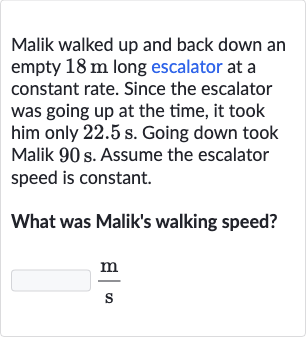Full solution
Q. Malik walked up and back down an empty long escalator at a constant rate. Since the escalator was going up at the time, it took him only . Going down took Malik s. Assume the escalator speed is constant.What was Malik's walking speed?
- Define variables: Define the variables for Malik's walking speed and the escalator speed.Let's denote Malik's walking speed as (in meters per second) and the escalator speed as (in meters per second).
- Set up equations: Set up the equations based on the given information.When Malik is going up, the escalator's speed adds to his walking speed, so the total speed is . It takes him . seconds to cover the meters, so we have the equation:When going down, the escalator's speed subtracts from his walking speed, so the total speed is . It takes him seconds to cover the same distance, so we have the equation:
- Solve first equation: Solve the first equation for .Calculate the right side of the equation. m/s
- Solve second equation: Solve the second equation for .Calculate the right side of the equation. m/s
- Add equations: Add the two equations to solve for Malik's walking speed .Now, divide both sides by to find .Calculate the value of . m/s
More problems from Interpret confidence intervals for population means
QuestionGet tutor help
QuestionGet tutor help
QuestionGet tutor help
QuestionGet tutor help
QuestionGet tutor help
QuestionGet tutor help

